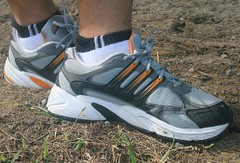FUNCTIONS OF THE SKELETON:
- Support - The skeleton holds the body off the ground and keeps its shape even when muscles are contracting to produce movement.
- Protection - The brain is protected from injury by being enclosed in the skull. The heart, lungs and liver are protected by the rib cage and the spinal cord is enclosed inside the backbone.
- Movement and Locomotion - Many bones of the skeleton acts as levers. When muscles pull on these bones, they produce movements such as the raising of the ribs during breathing or the chewing action of the jaws. For a skeletal muscle to produce movement, both its ends need to have a firm attachment. The skeleton provides suitable points of attachment for the ends of muscles. The skeleton with the help of muscles also helps to move the body from one place to another. This is called locomotion.
- Production of blood cells - The red bone marrow of some bones produce both red and white blood cells.
Note: You should be able to identify the humerus, ulna, radius, femur, tibia, fibula, pelvic girdle, pectoral girdle and of course the skull, ribs and rib cage, sternum and skull. JOINTS:
JOINTS:
 JOINTS:
JOINTS:- Where two bones meet they form a joint.
- In the syllabus, you only have to know the hinge and the ball and socket joints.
- Where can these joints be found? Hinge joints are found at your elbows and your knees whereas the ball and socket joint are usually found at your shoulder and your hip.
- The differences between these two types of joints are: hinge joints only allow movement in one direction only (for example bending your knee and your arm) whereas the ball and socket joints allow movement in all direction.
- The cartilage functions in reducing friction between two bones as shown in the figure above.
- Friction is further reduced by the synovial fluid which is produced by the synovial membrane.
- The function of the ligaments is to hold bones in position thus preventing dislocation. Dislocation may occurs if the ligaments are torn.
ANTAGONISTIC ACTION OF THE BICEPS AND TRICEPS IN THE ARM
- You need to know the role the biceps and triceps (these are known as skeletal muscles) in your arm which helps in bringing about movement such as when you are flexing or stretching your arm.
- Arm flexing - Biceps contracts while triceps relaxes.
- Arm stretching - Biceps relaxes while triceps contracts.



